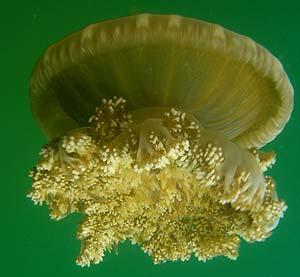An international study has created the world’s first global database of jellyfish records, finding a range of jellyfish has evolved to adapt to all available environmental conditions and making the first global estimates of the amount of jellyfish in our oceans.
The National Oceanography Centre’s Dr Daniel Jones, who co-authored the paper said “The JeDI database will be an extremely useful resource for scientists and is already allowing us to gain important insights into jellyfish distributions and their causes.”
Dr Cathy Lucas from the University of Southampton, who led the study, said the successful development of this first global-scale database of jellyfish records by the Global Jellyfish Group was due largely to the incredible generosity of members in the international jellyfish research and wider scientific communities.
Lead co-author, Dr Rob Condon of the University of North Carolina said “With this resource, anyone can use JeDI to address questions about the spatial and temporal extent of jellyfish populations at local, regional and global scales, and the potential implications for ecosystem services and biogeochemical processes.”
Using data from JeDI, the authors were able to show that jellyfish and other gelatinous zooplankton are present throughout the world’s oceans, with the greatest concentrations in the mid-latitudes of the Northern Hemisphere. In the North Atlantic Ocean, dissolved oxygen and sea surface temperature were found to be the principal drivers of jellyfish biomass distribution.
The spatial analysis carried out by the researchers is an essential first step in the establishment of a consistent database of gelatinous presence from which future trends can be assessed and hypotheses tested, particularly those relating to multiple regional and global drivers of jellyfish biomass.
The study complements the findings of a 2013 study, led by Dr Condon, in which global jellyfish populations were shown to exhibit fluctuations over multidecadal time-scales centred round a baseline.
Dr Condon said: “If jellyfish biomass does increase in the future, particularly in the Northern Hemisphere, this may influence the abundance and biodiversity of zooplankton and phytoplankton, having a knock-on effect on ecosystem functioning, biogeochemical cycling and fish biomass.”
JeDI is the first scientifically-coordinated global-scale database of jellyfish records, and currently holds over 476,000 data items on jellyfish and other gelatinous taxa. JeDI has been designed as an open-access database for all researchers, media and public to use as a current and future research tool and a data hub for general information on jellyfish populations. It is housed at the National Center for Ecological Analysis and Synthesis (NCEAS) USA, a cross-discipline ecological and data synthesis research centre affiliated with the University of California, Santa Barbara, and can be accessed and searched at http://jedi.nceas.ucsb.edu.
The continued development of JeDI and a re-analysis several decades from now will enable science to determine whether jellyfish biomass and distribution alter as a result of anthropogenic climate change.
The results of the study appear in Global Ecology and Biogeography. Other co-authors also include Professor Carlos Duarte of the University of Western Australia’s Oceans Institute and the Instituto Mediterráneo de Estudios Avanzadoes (IMEDEA) in Spain, Dr Kylie Pitt of Griffith University in Australia and members of the Global Jellyfish Group, a consortium of approximately 30 researchers from around the globe with specialisms in gelatinous organisms, climatology, oceanography and times-series analyses.

